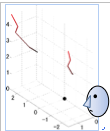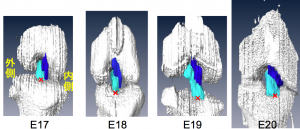
共同研究者の岸本さん、清水先生ら(東京農工大)が医用画像研究会(MI)で発表されました。
2015.09.08 電気通信大学(調布市)
ヒト胚子の眼球を対象とした時空間統計モデルに関する初期検討
岸本 将志、斉藤 篤、大坂 美穂、高桑 徹也、山田 重人、清水 昭伸
|
||||
|
共同研究者の岸本さん、清水先生ら(東京農工大)が医用画像研究会(MI)で発表されました。
8月6日、京都大学オープンキャンパスが行われました。人間健康科学科では400名、わたしたちの展示場にはのべ80人超の見学者が来訪致しました。ありがとうございました。
ダ・ビンチの時代から「かたち」は医学の基礎として重要な役割を担ってきました。人体を「かたち」作るさまざまなパーツや、生命の脅威のとなる病原菌などの「かたち」を詳しくみてみましょう… 第55回日本先天異常学会学術集会・第38回日本小児遺伝学会学術集会【合同開催】の合同開催で、いつもより盛会でした。 ヒト器官形成期における視覚器の発達について ヒト胚子期における気管支の分岐形成の三次元的解析 会 期: 2015年7月25日(土)~27日(月)
胚子期の脳、脳室の形態像に関する3次元データがMorphoMuseuMに受諾されました。 MorphoMuseuMは脊椎動物の三次元データと解剖記載のみを発行する学術誌でフランスのモンペリエ進化科学研究所(ISEM)主催しています。 3次元データは、博物館の展示物のように公開され、データは一定の条件のもと、自由に使用できるようになります。例えば、教科書の図や、3次元プリンターを利用したモデル化等、多くの用途への利用が考えられます。 本研究室では、立体データを今後も公開していく予定でいます。 Shiraishi N, Katayama A, Nakashima T, Shiraki N, Yamada S, Uwabe C, Kose K, Takakuwa T, 3D model related to the publication: Morphology of the human embryonic brain and ventricles, MorphoMuseuM 1 (3)-e3. doi: 10.18563/m3.1.3.e3. [OpenAccess]
 平日はひたすらスキャン 6/10−6/26、ドイツゲッチンゲン大学に共同研究者の山田先生、宮崎さん(山田研)、五十嵐さんの3名が、画像取得に出張いたしました。貴重なBlechshmidt collectionのうちの、連続組織標本をスキャニングしました。ご苦労さまです。 ゲッチンゲン大学解剖学教室は、昨年に引き続いての訪問になります。これからも定期的に伺うことになると思います。  張、高石、樋口君の論文が Plos oneに受諾されました。 ラットの膝関節の発生を、EFICを用いて検討しました。特にACL, PCL靭帯の形成に着目しました。 樋口君の卒業論文を基にして、例数を増やしてまとめました。
14. Xiangkai Zhang; Tomoki Aoyama; Ryota Takaishi; Shinya Higuchi; Shigehito Yamada; Hiroshi Kuroki; Tetsuya Takakuwa, Spatial change of cruciate ligaments in rat embryo knee joint by three-dimensional reconstruction.PLoS One. 2015 Jun 22;10(6):e0131092. doi: 10.1371/journal.pone.0131092. eCollection 2015. AbstractThis study aimed to analyze the spatial developmental changes of rat cruciate ligaments by three-dimensional (3D) reconstruction using episcopic fluorescence image capture (EFIC). Cruciate ligaments of Wister rat embryos between embryonic day (E) 16 and E20 were analyzed. Samples were sectioned and visualized using EFIC. 3D reconstructions were generated using Amira software. The length of the cruciate ligaments, distances between attachment points to femur and tibia, angles of the cruciate ligaments and the cross angle of the cruciate ligaments were measured. The shape of cruciate ligaments was clearly visible at E17. The lengths of the anterior cruciate ligament (ACL) and posterior cruciate ligament (PCL) increased gradually from E17 to E19 and drastically at E20. Distances between attachment points to the femur and tibia gradually increased. The ACL angle and PCL angle gradually decreased. The cross angle of the cruciate ligaments changed in three planes. The primordium of the 3D structure of rat cruciate ligaments was constructed from the early stage, with the completion of the development of the structures occurring just before birth.
S基盤研究(S)ヒト脳の形態形成から行動生成に至る発達のダイナミクスのメンバーが東京から来られ、研究についてのDiscussionを行いました。
2年ぶりなので演題をたくさん持って行きました。 「先天異常」というのは病理学の大事な分野の一つなのですが、病理学会内で、私たちと類似のことを行っている研究室はないようです。 (口演1) 膝関節の形態形成; EFICを用いた3次元的解析 (示説6) 3次元プリンタを用いたヒト胚子由来立体模型の作製 関節軟骨の最表層は3層の構造で構成される ヒト胚子期における側脳室脈絡叢の形態、組織学的研究 胎児側脳室の形態と長さ計測の有用性 ヒト胚子期の胃の形態形成と3次元的な動き ヒト胎児の肝臓形態形成 |
||||